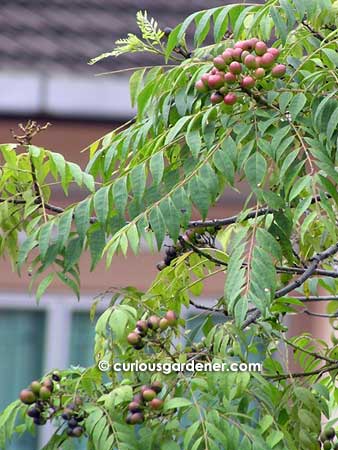
Mmm... cherry tomatoes!
Before I started growing tomatoes, I did my research about the best ways to grow them – how to germinate the seeds, transplant issues, etc. The part that gave me most pause was considering the best way to support the plants.
My handicap was having no experience in growing tomatoes before. Without the understanding of how the vine grows, I had to rely on the advice of others that I gleaned from the Net. Tomato cages, staking and different trellis options swirled in my head until I did my usual Curious Gardener thing and decided to try different approaches to see which suited me.
Firstly, observing how the first vine grew helped me a lot. I had expected it to grow like other vines – a long, winding or leaning stem – but that’s not how the tomato plant grows. My tomato plants are indeterminate, so I found that the plant grows a bit, then branches; then those branches grow a bit, and start branching out as well. Soon, you can have one wild plant growing all over the place!
Tomato experts advise trimming away the suckers (or side branches) so that the plant can focus its energy on growing a nice, strong main stem, especially before the fruits start growing. I agree with that. So, because of this, I cast my vote for the staking method, where you have a nice long stake that you tie the plant to as it grows taller. The only thing about this is that I’ve found that at a certain point, the plant branches so much that you’re not sure which vine to trim off. At least, that’s how my Thai Cherry Roma tomato plants have grown (yes, finally figured out what type they are, thanks to my cousin!). Pruning is a good thing, because I would likely need a ladder and a really long support stake as the plant grows more!
Here are the different methods I’ve tried…

Training the tomato plant to grow up a single stake - neat and healthy for the plant. Just look at the number of tomatoes on it - almost 30! I wish I'd used a taller support, though!
The stake method: Keeping a single, main stem allows the plant to channel its energy into developing a nice, strong stem that grows numerous healthy fruits. You also maximize the use of space and have better air circulation. Less shade + good air circulation = fewer problems and more fruits! In theory, anyway.

This picture has obviously been Photoshopped, but it was the best way to demonstrate how the vine grows when left unchecked. Without pruning, it gets overcrowded ...fast. This is not a good way to grow the plant.
The “wild” method: Without trimming off suckers, the plant becomes heavy and droops to the ground too much. There are too many branches and leaves, leading (for me) to white fly infestation. Fruits tend to be blemished with at least one or more black spots/insect bites.
I’m not sure that I want to try a tomato cage because I think the plant will get too bushy and become a haven for white flies and other pests. It may work in cooler climates, but possibly not in humid, tropical Singapore. If any of you live in a similar climate but have had success with the cage, do leave a note below.
Other varieties of tomato plants may grow in a different manner, but the above are my observations based on my tomato plants. For the next round, I’ll probably use a taller stake to see how the plant reacts – will it be healthier? Or will it only grow to a certain height? It’s fun approaching gardening this way; it keeps the anticipation there!
© 2010 curiousgardener.com All rights reserved.
![]()






